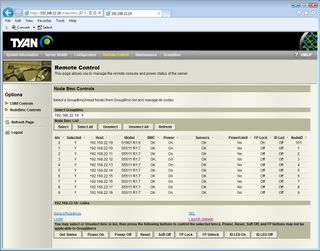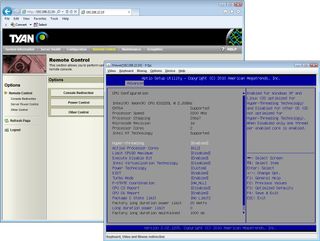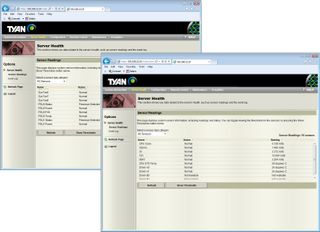For storage, each node motherboard has a single embedded SATA II port and a second SATA port on a bridgeboard behind it. Serverous offers a good choice of SFF disks and we had a pair of 250GB Toshiba 7.2k Enterprise drives fitted on each node and configured as mirrors.
The rear end of the node bridgeboard mates with the chassis mid-plane where it receives power from the load balanced supplies. The nodes have a single embedded Gigabit port and this is routed through to a passthrough blade at the front so each one has a dedicated network connection.

The chassis' own CMM provides remote web browser management and direct access to all server nodes
Remote management
A chassis management module (CMM) provides web browser access directly to the chassis and the passthrough blade has a separate port at the bottom for this function. The interface is basic when compared to the likes of HP's and Dell's blade servers but it does provide status information on all system fans, power supplies and temperatures.
Each node has its own baseboard management controller (BMC) and they can all be accessed directly from the CMM interface. The remote control section provides a list of all installed nodes, the model type and their status. They can be selected en mass or individually and a row of buttons at the bottom of the screen allows you to power them on and off, reset them or gracefully power them down.
KVM-over-IP remote control is included as standard and this can be fired up for any selected node directly from the CMM console. The IPMI controller on each node has its own web interface so they can also be accessed remotely via the passthrough blade without going through the CMM console.

Remote control can be fired up from the CMM interface or from the node's own web management console
The IPMI chip also provides virtual media services which are configured from the remote control window. You can select an optical drive, USB device, ISO image or floppy image on the guest system and present it to the node as a local bootable storage device.
Plenty of alerting facilities are on offer for the chassis and the nodes. Four event severity levels are available and if a sensor goes outside its predefined thresholds alerts can be issued via email or SNMP trap.

Critical components in the chassis and on each node can be remotely monitored and alerts issued when thresholds are breached
Dave is an IT consultant and freelance journalist specialising in hands-on reviews of computer networking products covering all market sectors from small businesses to enterprises. Founder of Binary Testing Ltd – the UK’s premier independent network testing laboratory - Dave has over 45 years of experience in the IT industry.
Dave has produced many thousands of in-depth business networking product reviews from his lab which have been reproduced globally. Writing for ITPro and its sister title, PC Pro, he covers all areas of business IT infrastructure, including servers, storage, network security, data protection, cloud, infrastructure and services.

